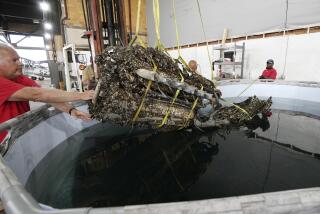Frank Kurtz; World War II Aviation Hero
Col. Frank Kurtz, Olympic medalist diver and the most decorated Army Air Corps pilot in World War II known for flying the last surviving B-17 Flying Fortress, has died. He was 85.
The legendary hero died Thursday at his Toluca Lake home from complications after a fall, said his wife, author Margo Kurtz.
An Army pilot on duty in the Philippines when the Japanese drew the United States into the war, Kurtz flew the last of the 35 planes stationed in the Pacific. When the plane was chewed up in combat, Kurtz and his crew dubbed it âpart swan and part goose--the Swoose.â It has been called the most famous plane in the Pacific except for the Enola Gay, which carried the atom bomb dropped on Hiroshima.
After flying the big plane home, Kurtz went to the European theater where he headed âthe Swoose Groupâ and personally flew more than 60 missions over Italy and Germany. In 1949, he was given the honor of flying the Swoose to the Smithsonian.
When Kurtzâs only child was born in Los Angeles during the war, news media immediately nicknamed her the second Swoose and the name stuck. She grew up to be the actress Swoosie Kurtz.
Kurtzâs wartime exploits earned him an international reputation and the Croix de Guerre, three Distinguished Flying Crosses, three silver stars, three air medals and five presidential citations. His remarkable story was detailed in a book by W.L. White titled âQueens Die Proudly.â
His wife told their personal story in a best-selling book titled âMy Rival, The Sky.â
One of Kurtzâs most celebrated postwar flights was crash-landing a Swoose in the Australian bush with no injury to his passengers--then Sen. Lyndon B. Johnson and a congressional committee.
Kurtz came from Missouri, and at the age of 14, hitchhiked to Los Angeles seeking top diving coaches. He developed as an athlete at Hollywood High School and USC. When Los Angeles hosted the Olympics in 1932, Kurtz competed in high platform diving. He won a bronze medal.
Kurtz also competed in the 1936 Olympics in Berlin and qualified for the games in 1940, which were canceled because of the war. Years later he served on the Olympic Committee and helped bring the 1984 games back to Los Angeles.
Anticipating a career in commercial aviation, Kurtz joined the Army to train as a pilot. Before the war, he held the national junior transcontinental speed record and established half a dozen other speed marks for light planes.
When he retired from the military, Kurtz became a top executive at the William May Garland development firm.
Survivors include his wife and daughter, who have requested that any memorial donations be made to the Smithsonian Air and Space Museum.
More to Read
Go beyond the scoreboard
Get the latest on L.A.'s teams in the daily Sports Report newsletter.
You may occasionally receive promotional content from the Los Angeles Times.










